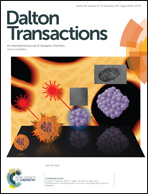Constructing novel Cd(ii) metal–organic frameworks based on different highly connected secondary building units via alteration of reaction conditions†
Abstract
Upon solvothermal reactions between Cd(II) salt and 5-pyridyl-tetrazolate (4-Ptz) under different reaction conditions, three new Cd(II) metal–organic frameworks (MOFs), namely [Cd3(4-Ptz)5(H2O)2(μ3-OH)·3DMA·5H2O·CH3OH]n (1), [Cd5(4-Ptz)8(CH3OH)2(μ3-OH)2·2DMA·4H2O·3CH3OH]n (2) and [{Cd9(4-Ptz)14(AC)2(μ3-OH)2(H2O)4}·8DMA·H2O·3CH3OH]n (3), were synthesized based on different highly connected secondary building units (SBUs). In the presence of triethylamine, 1 was constructed based on an 8-connected triangular trinuclear Cd3 SBU and exhibits a three-dimensional framework, while 2 was generated upon the addition of HCl, assembled through a close packing of the octahedron cages consisting of unprecedented 12-connected 4-Ptz bridged Cd5 SBUs and thus showing high thermal and chemical stability. For generating 3, two different kinds of Cd3 SBUs, including an 8-connected triangular SBU and a 10-connected linear SBU, were constructed and further integrated into a distorted octahedron-based net under the addition of both triethylamine and NaCl. In addition to the structural analysis, we also focused on the investigation of gas adsorption and solid-state fluorescence properties of 2.


 Please wait while we load your content...
Please wait while we load your content...